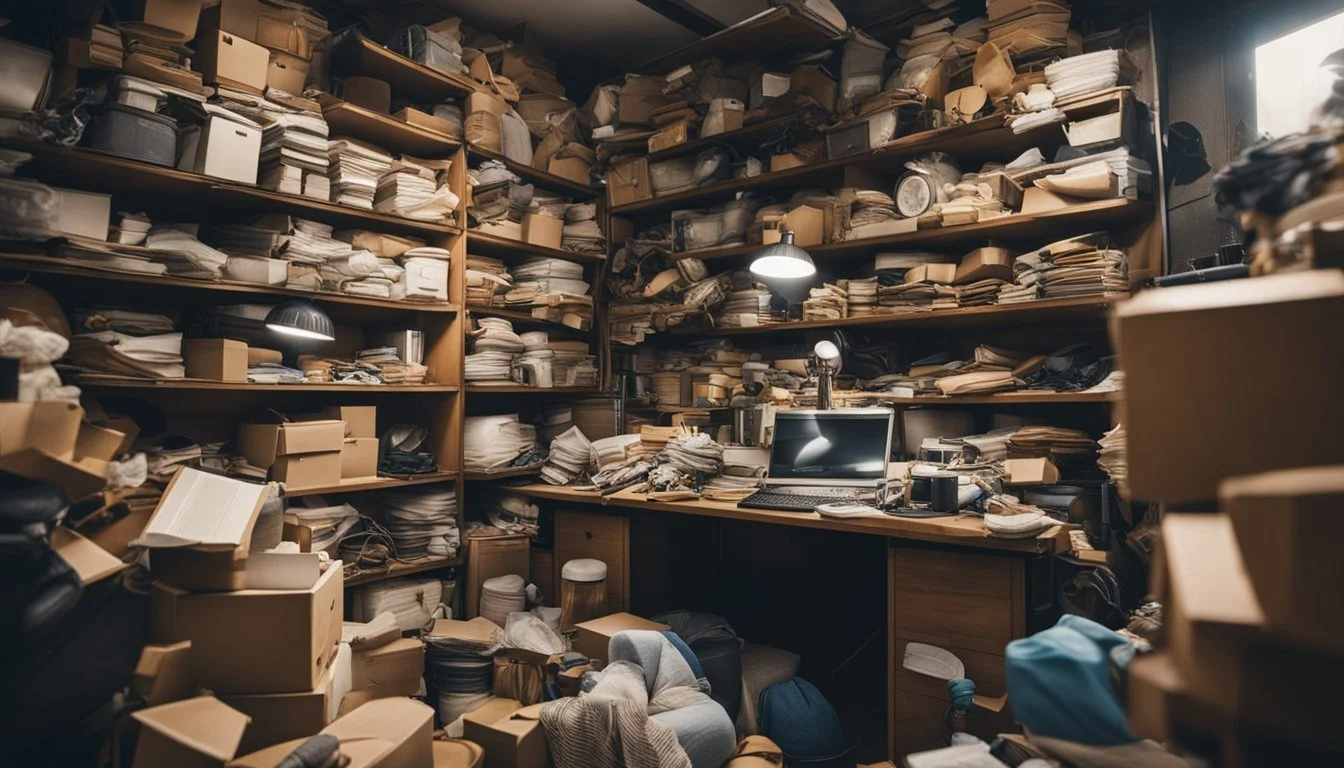6 Documentaries That Discuss the Psychological Aspects of Hoarding
Unveiling Hidden Minds
Hoarding, a complex psychological condition, affects millions worldwide and has gained notable attention through various documentaries. These films explore the intricate mental processes behind the disorder, offering viewers insight into the lives and experiences of those affected by compulsive accumulation.
Understanding the psychological aspects of hoarding is crucial for recognizing the condition's impact on individuals and communities. Through compelling interviews and personal stories, documentaries shed light on the challenges faced by those struggling with hoarding disorder, highlighting both the emotional turmoil and potential paths to recovery.
1) 'Beyond Hoarding' by David Sutcliffe (2019)
'Beyond Hoarding' directed by David Sutcliffe presents an insightful perspective on the psychological challenges associated with hoarding disorder. This documentary provides a detailed exploration into the compulsive behaviors that lead individuals to accumulate excessive amounts of items, often to the point of disrupting their daily lives.
The film emphasizes the personal stories of those affected by hoarding, highlighting their struggles and the impact on their relationships. By examining these narratives, viewers gain a deeper understanding of the emotional and psychological drivers behind hoarding behaviors.
Prominent mental health experts contribute to the documentary, offering professional insights into hoarding as a psychiatric disorder. They discuss the latest treatment approaches aimed at helping individuals manage and overcome their compulsions.
2) 'Hoarders' on A&E (2009)
The documentary series "Hoarders" on A&E provides an intimate perspective into the lives of individuals dealing with compulsive hoarding disorder. The show highlights the significant emotional and psychological challenges that individuals and their families face. Each episode presents personal stories that illustrate the difficulty in managing this complex condition.
Viewers witness the efforts of experts, including psychologists and professional organizers, as they work with hoarders. The series emphasizes the importance of understanding the mental health elements involved in the disorder. Experts aim to assist individuals in overcoming the disorder while restoring a semblance of normalcy and safety to their lives.
"Hoarders" is known for its empathetic portrayal rather than sensationalism, focusing on recovery and highlighting the potential for positive transformation. The series has gained recognition, being nominated for Emmy and Critics Choice Television Awards. Its impactful storytelling is both engaging and educational, offering a profound view into a significant mental health issue.
For more information, visit the Wikipedia page.
3) 'Stuff: Compulsive Hoarding and the Meaning of Things' by Randy Frost (2011)
This documentary explores the complex psychological aspects of hoarding through the lens of Randy Frost's work. As a professor and renowned psychologist, Frost examines why individuals develop compulsive hoarding habits, shedding light on the emotional and cognitive difficulties they face.
Frost and co-author Gail Steketee provide in-depth insights into the difference between collecting and hoarding. They highlight behaviors such as acquiring numerous items and struggling to discard them, which can significantly disrupt daily functioning and relationships.
Through real-life case studies, the film illustrates how the disorder impacts hoarders and their families. Personal stories reveal the struggles faced by individuals who hoard, offering viewers a deeper understanding of the severe consequences of compulsive hoarding.
The documentary is based on the book "Stuff: Compulsive Hoarding and the Meaning of Things," a New York Times bestseller that has been pivotal in increasing awareness about hoarding. It serves as an essential resource for understanding the psychological dimensions of this complex issue.
For more information on the documentary, visit the IMDB page.
4) 'The Hoarder Next Door' on Channel 4 (2012)
"The Hoarder Next Door" is a British documentary series focusing on individuals who struggle with compulsive hoarding. It aired on Channel 4 and ran from May 2012 to April 2014.
The series features psychotherapist Stelios Kiosses, who works closely with hoarders to help them manage their condition. Throughout the show, viewers witness the challenges faced by hoarders and the therapeutic strategies implemented to address these issues.
Narrated by Olivia Colman, the show brings to light personal stories, exploring the psychological dimensions of hoarding. The documentary not only highlights the emotional struggles but also illustrates the impact on families and communities.
Each episode offers a compassionate look at the steps taken towards recovery, emphasizing both the difficulties and triumphs involved. The series strikes a balance between providing insight into the condition and offering hope through professional support.
For more details, check out Wikipedia.
5) 'Consumed: Inside the Belly of the Beast' featuring Andrea Arnold (2011)
'Consumed: Inside the Belly of the Beast,' directed by Richard Heap, is a documentary that delves into the psychological roots of modern consumer culture. It examines how evolution and psychology shape today's consumerist behaviors, presenting a critical narrative on the subject. The documentary explores the significant role that psychology plays in fueling consumption patterns.
Andrea Arnold is included in the documentary to offer insights into these consumerist tendencies. Her perspective helps to elucidate the connections between personal psychology and broader societal consumption patterns. The film uses interviews and historical archives to analyze how aspirations and ownership lead to a culture centered on consumption.
The documentary also investigates the emotional and psychological underpinnings behind these behaviors, making it relevant for understanding broader consumer-driven phenomena, like hoarding. It emphasizes the centrality of the human experience in this ongoing narrative, exploring the societal forces that drive people towards excessive consumption.
For more information on this documentary, visit its IMDb page.
6) 'My Crazy Obsession' on TLC (2012-2013)
"My Crazy Obsession" is a reality TV series that aired on TLC, featuring individuals with unusual fixations. The show dives into the lives of people whose obsessions border on compulsions, showcasing their collections and the impact these obsessions have on their daily lives.
While the primary focus isn't solely on hoarding, the themes often intersect, as collections sometimes reach extreme levels. Viewers get a firsthand look at how these obsessions manifest and the variety of items people fixate on.
The series ran from 2012 to 2013, and consisted of 18 episodes across two seasons. Episodes often include interviews with the individuals, offering insight into the psychology behind their passions.
This documentary series contributes to a broader understanding of how obsession and hoarding can intertwine, offering audiences a glimpse into extreme human behavior. For more information, refer to IMDb's page on "My Crazy Obsession".
Understanding Hoarding
Hoarding disorder is a complex psychological condition characterized by the persistent difficulty in discarding possessions and an overwhelming urge to accumulate items, ultimately leading to significant personal and environmental distress. This condition poses unique challenges in both diagnosis and treatment, with various psychological factors contributing to its development.
Definition and Symptoms
Hoarding disorder entails three core symptoms: difficulty discarding items, excessive acquisition, and pronounced disorganization. Individuals struggle to let go of possessions due to perceived emotional value or fear of needing them in the future. Most people with this condition also acquire new items, often leading to cluttered living spaces that interfere with daily functioning. The extent of clutter often prevents people from moving through their spaces easily, posing serious health and safety risks. Diagnostic criteria for hoarding disorder include persistent difficulty discarding possessions, which results in clutter that considerably disrupts living areas. These symptoms must cause significant distress or impairment in social, occupational, or other functional areas.
Psychological Underpinnings
The psychological complexities of hoarding involve cognitive, emotional, and behavioral facets. Hoarding is often linked to obsessive-compulsive disorder (OCD), yet differs in that the distress is primarily associated with the prospect of losing accumulated items. Emotional attachments to possessions play a significant role, driving fear and anxiety about letting go. Cognitive dysfunction in decision-making and organization contributes significantly to the disorder. People with hoarding disorder frequently experience emotional dysregulation, leading to difficulties in managing the attachments and anxiety related to their possessions. Treatment often involves cognitive-behavioral therapy, which seeks to address underlying anxieties and promote healthier decision-making processes.
Impact of Hoarding on Mental Health
Hoarding disorder is not just an issue of physical clutter; it deeply affects mental health. The emotional toll includes feelings of shame and anxiety. Social interactions often become strained due to the secretive and isolating nature of hoarding.
Emotional Consequences
Hoarding frequently leads to complex emotional struggles. Individuals often experience intense feelings of shame and guilt concerning their living conditions. These emotions can worsen anxiety and stress, creating a vicious cycle. Depression may develop, resulting in decreased motivation to manage or organize their environment.
Tackling these emotions is a significant hurdle in treatment, with many feeling overwhelmed by the prospect of change. Cognitive-behavioral therapy (CBT) often integrates strategies to address these emotions, seeking to alleviate anxiety and stress. Understanding these emotions is crucial for effective treatment and recovery.
Social Isolation
Social isolation is a common outcome of hoarding, impacting relationships with friends and family. Individuals affected by hoarding often withdraw, avoiding inviting others into their living spaces due to embarrassment. This withdrawal can lead to loneliness and exacerbate existing mental health struggles, such as depression and anxiety.
The stigma surrounding hoarding further alienates individuals, making them less likely to seek help. Efforts from both mental health professionals and personal support networks are necessary for overcoming this isolation. Supportive environments are vital in encouraging individuals to reach out and engage socially, serving as a crucial step toward recovery.




